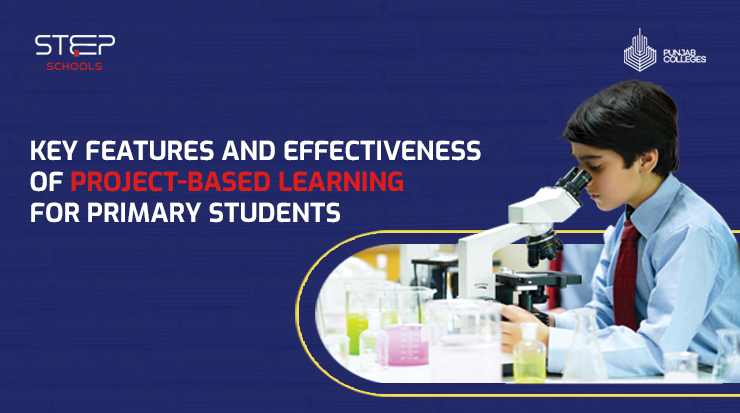Project-Based Learning (PBL) is a modern teaching method. It is a vertical deviation from the traditional way of learning, where learning from theories is the focus. In contrast, project-based learning (PBL) is a practical learning experience. This article explores the key features and effectiveness of project-based learning for primary students.
Introduction to Project-Based Learning (PBL)
Project-Based Learning (PBL) is a practical approach to learning. In contrast to traditional education, it offers a student’s-centric strategy to enable kids to understand the concept and its essentialities on a deeper level. Project base learning is available for better learning.
Key Features of Project-Based Learning
The primary key feature of project-based learning (PBL) is the practical way of learning. The project-based-learning (PBL) is the advanced form of experimental learning that is historically linked with Socrates. In the modern era, David Kolb is a significant contributor to disclosing the multi-dimensional nature of practical learning. Let’s learn about the prestigious features of PBL.
Project-Based Learning (PBL) is often mistaken for problem-based or enquiry-based learning. However, these are both separate. The distinctive features of project-based learning (PBL) are as follows.
Active Learning
The primary focus of project-based learning (PBL) is to change the learning mechanism. For instance, in traditional education, students learn through their learning ability. They listen to what their teachers tell them about anything.
On the contrary, learning based on any project (PBL) employs the way of learning through doing it. Students get a chance to take any project and do it by actively participating; hence, they get to know a lot about it.
Parents often love to see their children excited about school activities. Whereas, with the routine of traditional learning, students get bored about the various aspects and the excitement gets missed anywhere in between. However, project-based knowledge (PBL) ignites this passion again.
Real-World Problems
Taking real-world problems into consideration is another significant feature of practical learning based on project (PBL) . The real-life issues represent the authenticity of the problem under consideration. On the other hand, traditional education methods may present case studies for study purposes. However, it does not help in learning the problem deeper.
Teachers are Guides
As project-based learning is a student-centric approach, it dramatically advances the role of teachers or mentors. The teacher becomes a facilitator and observer under project-based learning. They also monitor the entire project from step one till final execution.
Interdisciplinary in Approach
Another prominent point of such a learning experience is its interdisciplinary approach. This means that students are no longer limited to one subject line. Instead, science subjects’ skills, knowledge, and understanding also intake social and natural sciences where applicable.
In this way, students get an opportunity to interlink various aspects of skills, knowledge, and demonstration as per applicability.
Encourages Cooperative Learning
Studies and literature review show that PBL emphasises the need and practicality of a team effort. In this way, students learn the importance of collaboration and unity for completion purposes on various levels.
In this way, students learn the most superior professional skills- teamwork and collaboration. Working with others often develops virtues like patience, understanding, adaptability, and people skills among students since primary education.
Result-Oriented Projects
Lastly, the key feature of project-based learning is that it incorporates the projects with a result-based approach. The main motive is to help students understand the working and mechanisms of subjects and various things in real-life to polish their perspective and vision towards the working of this life.
This feature helps students to plan, produce and evaluate the project from the initial step to the final throw.
Effectiveness of PBL
Students gain the following advantages by working on projects under project-based learning (PBL).
- A better understanding of the topic with its essence and technicalities.
- Students gain 21st-century skills and learning experience to develop strategies.
- A positive and accepting outlook towards learning and studies.
- Well-developed work ethics and habits for better future performances.
Project-Based Learning in Pakistan
In Pakistan, only a few educational institutions are implementing the project-based approach. Colleges and universities also follow the traditional learning experience in the 21st century. What to talk about the primary education or schools?
However, one school system is offering the project-based learning (PBL) opportunity with the latest STEAM education to cater to the needs of the 21st century in every aspect for a promising tomorrow.
Step Schools offer the latest education modules with STEAM education curriculum and e-learning programs with a well-connected mechanism that brings Parents- Children- Teachers together for rich and fruitful learning procedures.
Step Schools aim to develop 21st-century skills among students like critical thinking, communication, collaboration, and creativity to answer the quests of their future, which will be even more fast-paced than today with the emergence of technological advancements in various aspects.
Admissions are Open at Step Schools
The admissions 2023 for Nursery, primary, middle, and senior years are open. You can fill out the form and get your child to learn the education that will matter in their time.
Conclusion
Get your child to learn 21st-century skills with the practical project-based learning (PBL) approach. It is high time to prepare our young generation to lead the future of tomorrow.

